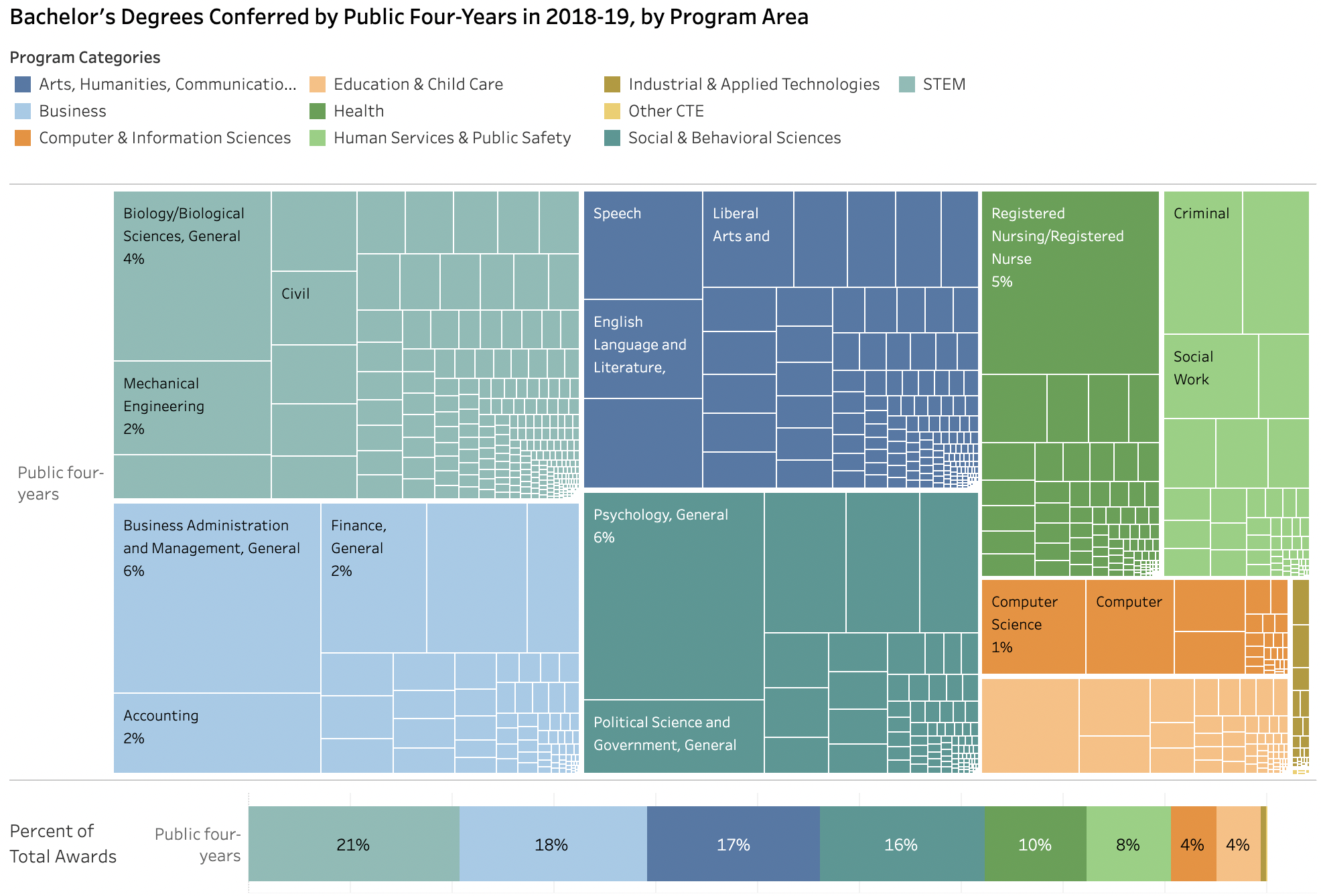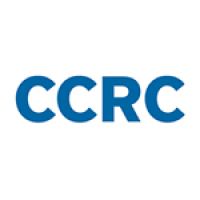By Davis Jenkins and John Fink
Over the past few months, community college leaders have gone to great lengths to recover from the pandemic enrollment crash and attract students back—through marketing campaigns, tuition incentives, and loan or fee forgiveness. All of these efforts are needed. However, to build back enrollment over the longer term, colleges must not only take steps to make it easier to attend college but also reevaluate their programmatic offerings to ensure that all programs lead to outcomes that make them worth the investment of time and money by students and their families.
A starting point is to ask some fundamental questions: What programs are our students completing, what do they lead to, and which groups of students are underrepresented in programs leading to stronger postgraduation outcomes? The data tool below offers a bird’s-eye view of what credentials are being completed at your college or in your state.
What college credentials are students completing?
This dashboard allows users to examine postsecondary credentials by level and program conferred by public postsecondary institutions, disaggregated by student race/ethnicity and gender. Using the tool, you can look up results for individual colleges, sets of colleges, or entire states. As described in a prior post, we adjust the IPEDS sector classification to better reflect the community college sector
While some community college programs clearly lead to greater opportunity after graduation (see this recent analysis from Third Way), many career-technical programs do not enable graduates to secure a good job immediately, and many baccalaureate transfer programs are poorly designed, so students’ credits may not transfer or apply to a bachelor’s degree in their major field of interest. If community college credentials do not prepare students to secure well-paying jobs or transfer to a bachelor’s program with few extraneous credits, why should students be motivated to enroll in and complete them?
The misalignment between community college credentials and strong employment and further education outcomes is one important but largely overlooked reason that community college enrollment declined steadily for a decade, even before the sharp drop that resulted from COVID. While colleges should continue to strengthen student outreach, this will not be sufficient to reverse the enrollment declines of the past year, let alone the past decade. Community colleges will also need to look at the curriculum and pedagogy of their programs and ensure that they are aligned with the requirements for good jobs in their areas and for transfer in popular majors at nearby universities.
How many community college programs lead directly to a good job?
According to the U.S. Department of Education’s IPEDS completions data (presented in the dashboard above), 25% of the awards given by two-year public institutions in 2018–19 were short-term certificates (for programs less than a year in length); another 16% were longer-term certificates (for programs of at least one year but less than two). Research on the returns to community college credentials shows that earning a short-term certificate by itself is generally not sufficient to enable students to advance to well-paying jobs. Longer-term certificates have stronger labor market returns, though these tend to level off over time.
In 2020, the Georgetown University Center on Education and the Workforce produced a report on sub-baccalaureate credentials that included median earnings of prime-working-age workers with sub-baccalaureate credentials by the type and field of the award. Comparing these data with the IPEDS completions data, we estimate that roughly 1 in 4 certificates and 1 in 3 associate degrees awarded by community colleges are held by workers with median annual earnings over $35,000, which the Georgetown Center has identified as a “good job.” Applying a similar approach to College Scorecard data, as analyzed by Third Way, we find that 35% of certificates and 44% of associate degrees awarded by public institutions are associated with median earnings of $35,000 or more two years after graduation.
These rough national estimates should be taken with a (large) grain of salt since the returns to specific credentials vary greatly across local labor markets. But it does seem clear that while some community college programs place graduates immediately into well-paying jobs, other programs do not. To better attract and retain students, colleges should be asking, “How many of our programs lead directly to good jobs in our communities, and how can we strengthen the value of our programs?”
How many transfer programs are well-aligned to bachelor’s degree majors?
Nearly 60% of community college awards in 2018–19 were associate degrees. The figure below shows the fields and specific majors of these associate degrees.

Nearly half (48%) of these associate degrees were in liberal arts and sciences/liberal studies/general studies. Compared with associate degrees in career-technical fields, the labor market returns to these academic degrees are weak. This is not surprising, given that academic associate degrees are generally designed to enable students to transfer to earn a bachelor’s degree. Given the strong returns to bachelor’s degrees, associate of arts degrees do have strong economic value if they enable students to transfer successfully. However, transfer-oriented associate degree programs are often not well aligned to bachelor’s degree programs. Too many students who earn these degrees and transfer have to take additional courses to meet major requirements and end up taking far more credits than are needed for a bachelor’s degree in their major field of interest.
This misalignment is apparent when you compare the fields of the associate degrees awarded by community colleges in the graphic above with the following one, which shows the field of the bachelor’s degrees awarded by four-year public institutions in the same year. Note, for example, that compared with the half of community college associate degrees in liberal arts, only 17% of these four-year college bachelor’s degrees were in arts, humanities, and communications.

To build back enrollments, programs must benefit students
The weak returns to many community college credentials are problematic, given that community college tuition has continued to increase and students and their families are bearing more of the costs of community college programs.
If students have to spend a year earning a long-term certificate that enables them to earn a job paying less than $17 per hour (the equivalent of $35,000 per year for full-time work) with no benefits, they might be better off skipping the community college program (especially in light of the low on-time completion rates of such programs) and getting a job at Amazon, Target, or another employer offering a $15 minimum wage and in some cases health benefits.
Similarly, if only around 1 in 7 students who start at a community college are successful in transferring and earning a bachelor’s degree in six years, and if many of those who do transfer end up having to take many more credits than they need for their bachelor’s degree, they might get a better return by going directly to a four-year institution. Indeed, over the past decade, community colleges have lost market share of traditional college-age students to public four-year universities, and we would expect competition from four-year public institutions and other sectors to increase as high school graduating classes are projected to decline in size in the coming years. COVID has only exacerbated these and other enrollment pressures on community colleges.
To address these challenges and build back the enrollment they have lost in recent years, community colleges will need to redouble their efforts to broaden access for prospective students and provide the supports needed to retain existing ones. At the same time, they will need to ensure that their programs lead to good jobs and/or transfer with few excess credits in fields of interest to students. Over the past six years, we and other colleagues at the Community College Research Center have been studying the efforts of hundreds of community colleges nationally that are seeking to do this through whole-college guided pathways reforms. For colleges just beginning to address these challenges, an important step is to assess whether the credentials they are awarding lead to outcomes that make their programs worthwhile investments for students. The data tool on completions by program shared in this blog and a similar exercise on unpacking program enrollments are a good place to start.





